Teddy Hotel: Revenue Management Analysis and Forecasting Report
VerifiedAdded on 2020/10/22
|13
|4487
|425
Report
AI Summary
This report provides a comprehensive analysis of revenue management strategies for the Teddy Hotel in London. It begins with an overview of revenue management principles and its application to the hotel industry. The report then delves into past demand analysis, comparing occupancy rates, ADR, and RevPAR for 2017. It explores pricing inventory, deriving price response functions for each market segment and comparing optimal prices with current rates. The report then moves into demand forecasting, utilizing optimal price findings to estimate expected demand and performing data decomposition to prepare seasonally adjusted data. The report forecasts anticipated room demand for the next year on a quarterly basis, comparing results from moving average and exponential smoothing methods. The discussion section analyzes the findings from both demand approaches, proposes optimal segment mix and distribution channels to maximize revenue, and assesses the feasibility of achieving the owner's financial expectations. The report concludes with recommendations for immediate and long-term changes, aimed at improving the hotel's revenue performance.
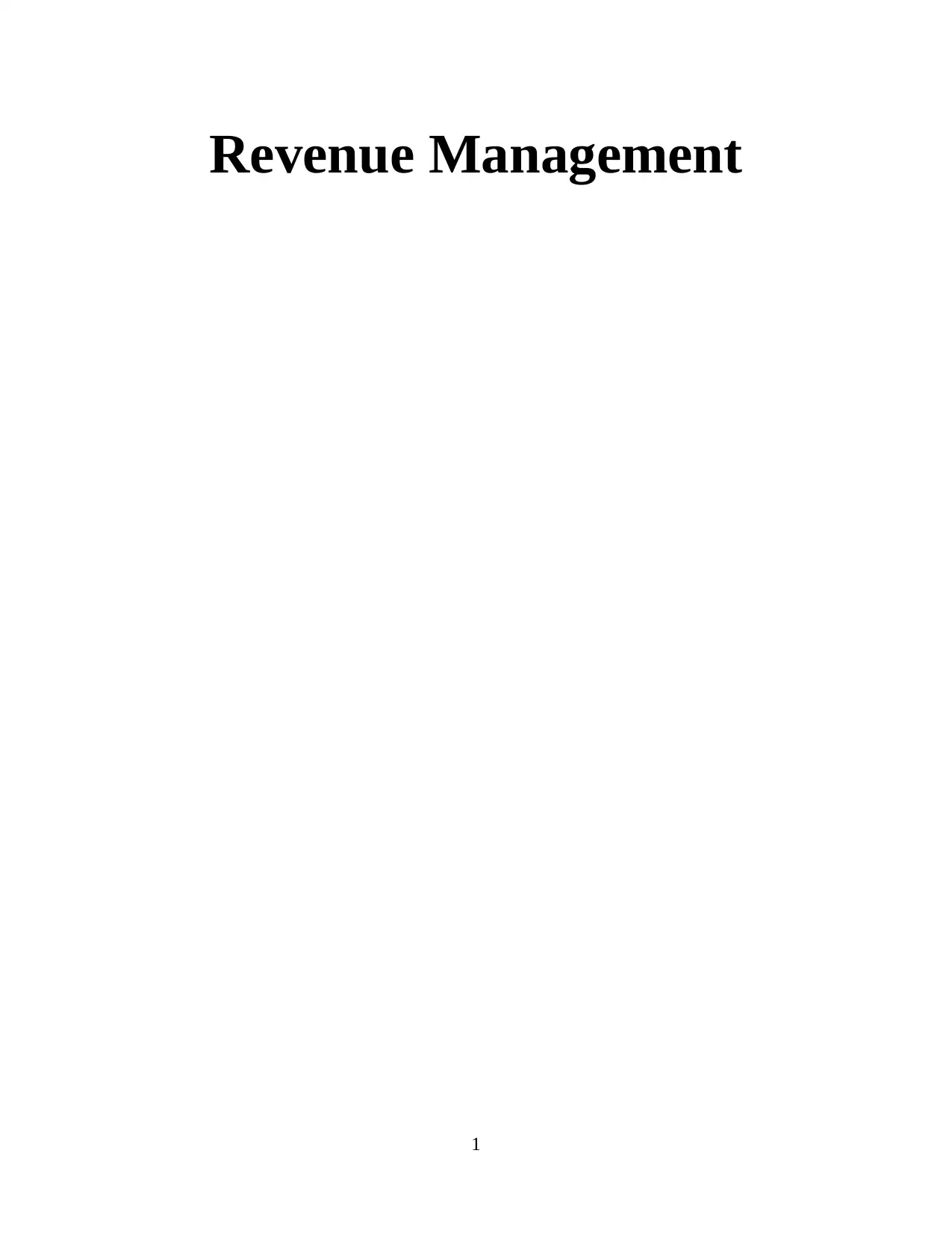
Revenue Management
1
1
Paraphrase This Document
Need a fresh take? Get an instant paraphrase of this document with our AI Paraphraser
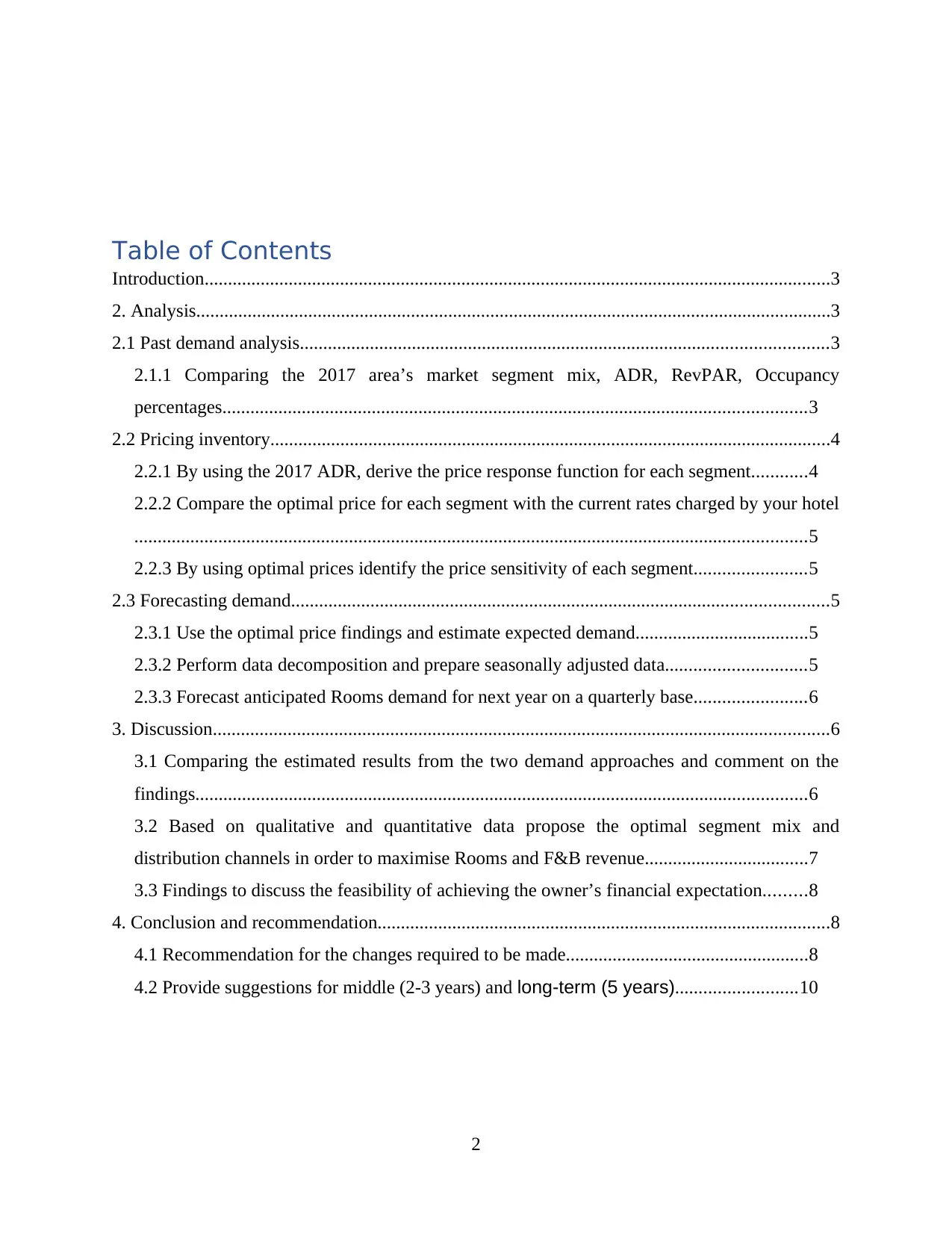
Table of Contents
Introduction......................................................................................................................................3
2. Analysis........................................................................................................................................3
2.1 Past demand analysis.................................................................................................................3
2.1.1 Comparing the 2017 area’s market segment mix, ADR, RevPAR, Occupancy
percentages.............................................................................................................................3
2.2 Pricing inventory........................................................................................................................4
2.2.1 By using the 2017 ADR, derive the price response function for each segment............4
2.2.2 Compare the optimal price for each segment with the current rates charged by your hotel
................................................................................................................................................5
2.2.3 By using optimal prices identify the price sensitivity of each segment........................5
2.3 Forecasting demand...................................................................................................................5
2.3.1 Use the optimal price findings and estimate expected demand.....................................5
2.3.2 Perform data decomposition and prepare seasonally adjusted data..............................5
2.3.3 Forecast anticipated Rooms demand for next year on a quarterly base........................6
3. Discussion....................................................................................................................................6
3.1 Comparing the estimated results from the two demand approaches and comment on the
findings...................................................................................................................................6
3.2 Based on qualitative and quantitative data propose the optimal segment mix and
distribution channels in order to maximise Rooms and F&B revenue...................................7
3.3 Findings to discuss the feasibility of achieving the owner’s financial expectation.........8
4. Conclusion and recommendation.................................................................................................8
4.1 Recommendation for the changes required to be made....................................................8
4.2 Provide suggestions for middle (2-3 years) and long-term (5 years)..........................10
2
Introduction......................................................................................................................................3
2. Analysis........................................................................................................................................3
2.1 Past demand analysis.................................................................................................................3
2.1.1 Comparing the 2017 area’s market segment mix, ADR, RevPAR, Occupancy
percentages.............................................................................................................................3
2.2 Pricing inventory........................................................................................................................4
2.2.1 By using the 2017 ADR, derive the price response function for each segment............4
2.2.2 Compare the optimal price for each segment with the current rates charged by your hotel
................................................................................................................................................5
2.2.3 By using optimal prices identify the price sensitivity of each segment........................5
2.3 Forecasting demand...................................................................................................................5
2.3.1 Use the optimal price findings and estimate expected demand.....................................5
2.3.2 Perform data decomposition and prepare seasonally adjusted data..............................5
2.3.3 Forecast anticipated Rooms demand for next year on a quarterly base........................6
3. Discussion....................................................................................................................................6
3.1 Comparing the estimated results from the two demand approaches and comment on the
findings...................................................................................................................................6
3.2 Based on qualitative and quantitative data propose the optimal segment mix and
distribution channels in order to maximise Rooms and F&B revenue...................................7
3.3 Findings to discuss the feasibility of achieving the owner’s financial expectation.........8
4. Conclusion and recommendation.................................................................................................8
4.1 Recommendation for the changes required to be made....................................................8
4.2 Provide suggestions for middle (2-3 years) and long-term (5 years)..........................10
2
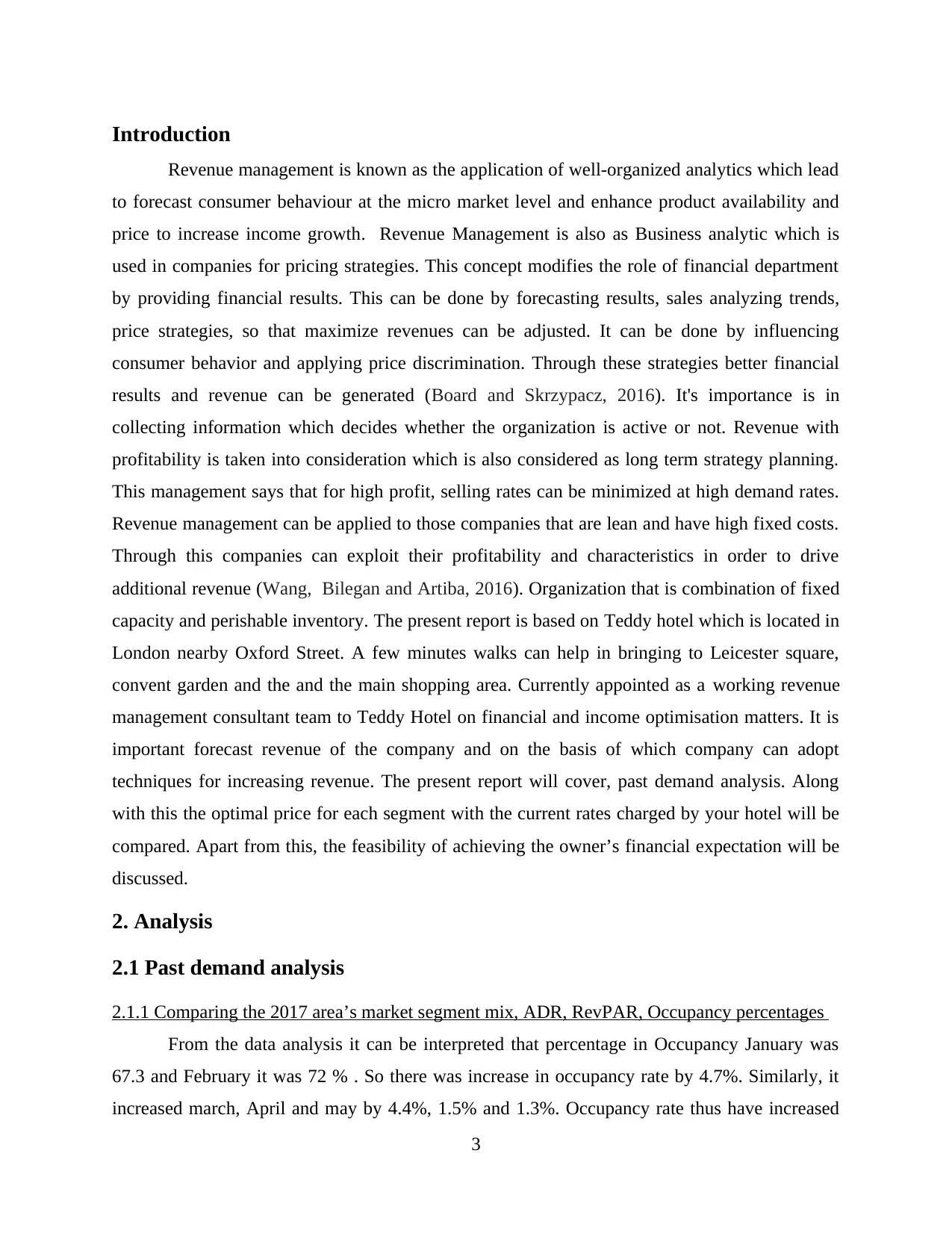
Introduction
Revenue management is known as the application of well-organized analytics which lead
to forecast consumer behaviour at the micro market level and enhance product availability and
price to increase income growth. Revenue Management is also as Business analytic which is
used in companies for pricing strategies. This concept modifies the role of financial department
by providing financial results. This can be done by forecasting results, sales analyzing trends,
price strategies, so that maximize revenues can be adjusted. It can be done by influencing
consumer behavior and applying price discrimination. Through these strategies better financial
results and revenue can be generated (Board and Skrzypacz, 2016). It's importance is in
collecting information which decides whether the organization is active or not. Revenue with
profitability is taken into consideration which is also considered as long term strategy planning.
This management says that for high profit, selling rates can be minimized at high demand rates.
Revenue management can be applied to those companies that are lean and have high fixed costs.
Through this companies can exploit their profitability and characteristics in order to drive
additional revenue (Wang, Bilegan and Artiba, 2016). Organization that is combination of fixed
capacity and perishable inventory. The present report is based on Teddy hotel which is located in
London nearby Oxford Street. A few minutes walks can help in bringing to Leicester square,
convent garden and the and the main shopping area. Currently appointed as a working revenue
management consultant team to Teddy Hotel on financial and income optimisation matters. It is
important forecast revenue of the company and on the basis of which company can adopt
techniques for increasing revenue. The present report will cover, past demand analysis. Along
with this the optimal price for each segment with the current rates charged by your hotel will be
compared. Apart from this, the feasibility of achieving the owner’s financial expectation will be
discussed.
2. Analysis
2.1 Past demand analysis
2.1.1 Comparing the 2017 area’s market segment mix, ADR, RevPAR, Occupancy percentages
From the data analysis it can be interpreted that percentage in Occupancy January was
67.3 and February it was 72 % . So there was increase in occupancy rate by 4.7%. Similarly, it
increased march, April and may by 4.4%, 1.5% and 1.3%. Occupancy rate thus have increased
3
Revenue management is known as the application of well-organized analytics which lead
to forecast consumer behaviour at the micro market level and enhance product availability and
price to increase income growth. Revenue Management is also as Business analytic which is
used in companies for pricing strategies. This concept modifies the role of financial department
by providing financial results. This can be done by forecasting results, sales analyzing trends,
price strategies, so that maximize revenues can be adjusted. It can be done by influencing
consumer behavior and applying price discrimination. Through these strategies better financial
results and revenue can be generated (Board and Skrzypacz, 2016). It's importance is in
collecting information which decides whether the organization is active or not. Revenue with
profitability is taken into consideration which is also considered as long term strategy planning.
This management says that for high profit, selling rates can be minimized at high demand rates.
Revenue management can be applied to those companies that are lean and have high fixed costs.
Through this companies can exploit their profitability and characteristics in order to drive
additional revenue (Wang, Bilegan and Artiba, 2016). Organization that is combination of fixed
capacity and perishable inventory. The present report is based on Teddy hotel which is located in
London nearby Oxford Street. A few minutes walks can help in bringing to Leicester square,
convent garden and the and the main shopping area. Currently appointed as a working revenue
management consultant team to Teddy Hotel on financial and income optimisation matters. It is
important forecast revenue of the company and on the basis of which company can adopt
techniques for increasing revenue. The present report will cover, past demand analysis. Along
with this the optimal price for each segment with the current rates charged by your hotel will be
compared. Apart from this, the feasibility of achieving the owner’s financial expectation will be
discussed.
2. Analysis
2.1 Past demand analysis
2.1.1 Comparing the 2017 area’s market segment mix, ADR, RevPAR, Occupancy percentages
From the data analysis it can be interpreted that percentage in Occupancy January was
67.3 and February it was 72 % . So there was increase in occupancy rate by 4.7%. Similarly, it
increased march, April and may by 4.4%, 1.5% and 1.3%. Occupancy rate thus have increased
3
⊘ This is a preview!⊘
Do you want full access?
Subscribe today to unlock all pages.

Trusted by 1+ million students worldwide
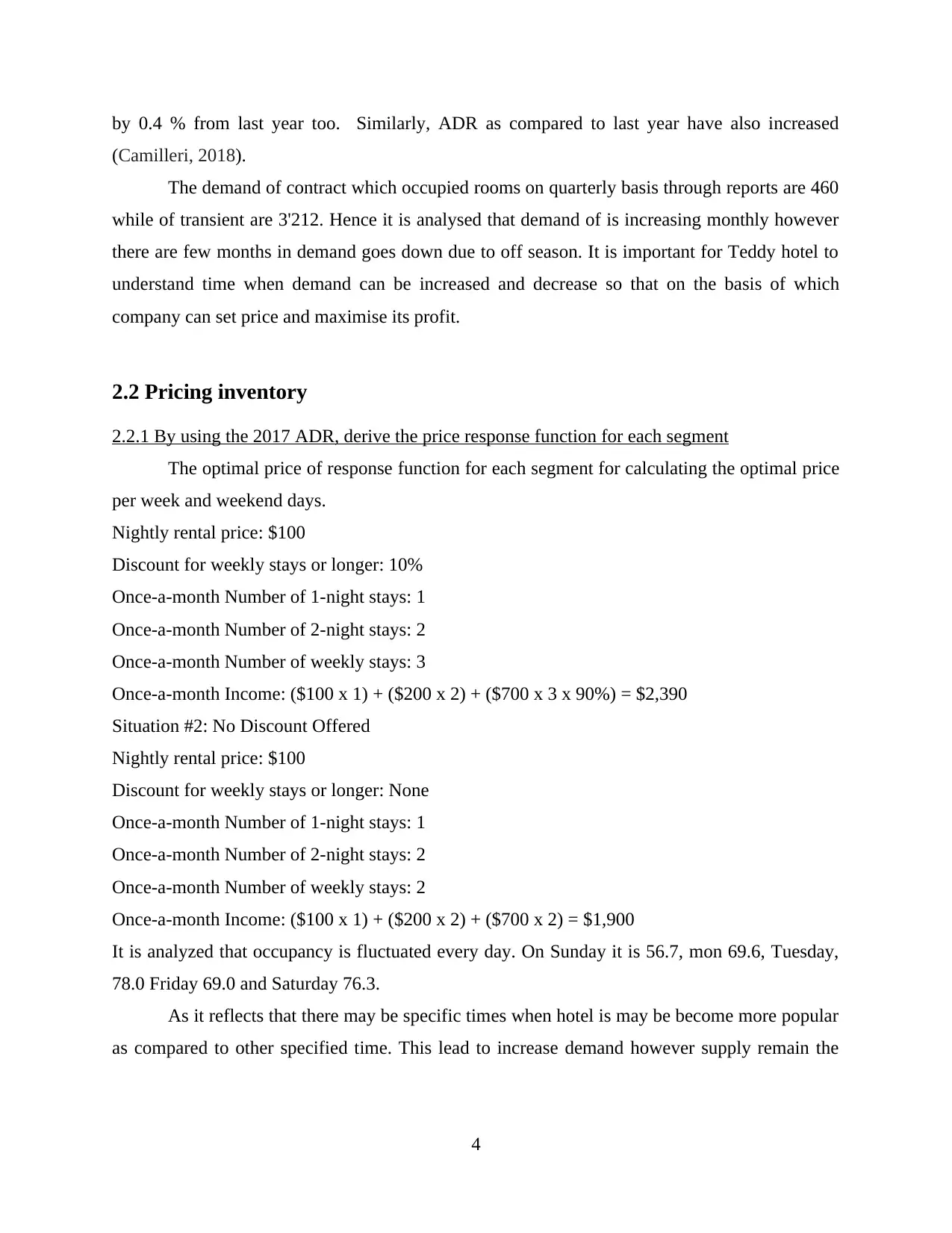
by 0.4 % from last year too. Similarly, ADR as compared to last year have also increased
(Camilleri, 2018).
The demand of contract which occupied rooms on quarterly basis through reports are 460
while of transient are 3'212. Hence it is analysed that demand of is increasing monthly however
there are few months in demand goes down due to off season. It is important for Teddy hotel to
understand time when demand can be increased and decrease so that on the basis of which
company can set price and maximise its profit.
2.2 Pricing inventory
2.2.1 By using the 2017 ADR, derive the price response function for each segment
The optimal price of response function for each segment for calculating the optimal price
per week and weekend days.
Nightly rental price: $100
Discount for weekly stays or longer: 10%
Once-a-month Number of 1-night stays: 1
Once-a-month Number of 2-night stays: 2
Once-a-month Number of weekly stays: 3
Once-a-month Income: ($100 x 1) + ($200 x 2) + ($700 x 3 x 90%) = $2,390
Situation #2: No Discount Offered
Nightly rental price: $100
Discount for weekly stays or longer: None
Once-a-month Number of 1-night stays: 1
Once-a-month Number of 2-night stays: 2
Once-a-month Number of weekly stays: 2
Once-a-month Income: ($100 x 1) + ($200 x 2) + ($700 x 2) = $1,900
It is analyzed that occupancy is fluctuated every day. On Sunday it is 56.7, mon 69.6, Tuesday,
78.0 Friday 69.0 and Saturday 76.3.
As it reflects that there may be specific times when hotel is may be become more popular
as compared to other specified time. This lead to increase demand however supply remain the
4
(Camilleri, 2018).
The demand of contract which occupied rooms on quarterly basis through reports are 460
while of transient are 3'212. Hence it is analysed that demand of is increasing monthly however
there are few months in demand goes down due to off season. It is important for Teddy hotel to
understand time when demand can be increased and decrease so that on the basis of which
company can set price and maximise its profit.
2.2 Pricing inventory
2.2.1 By using the 2017 ADR, derive the price response function for each segment
The optimal price of response function for each segment for calculating the optimal price
per week and weekend days.
Nightly rental price: $100
Discount for weekly stays or longer: 10%
Once-a-month Number of 1-night stays: 1
Once-a-month Number of 2-night stays: 2
Once-a-month Number of weekly stays: 3
Once-a-month Income: ($100 x 1) + ($200 x 2) + ($700 x 3 x 90%) = $2,390
Situation #2: No Discount Offered
Nightly rental price: $100
Discount for weekly stays or longer: None
Once-a-month Number of 1-night stays: 1
Once-a-month Number of 2-night stays: 2
Once-a-month Number of weekly stays: 2
Once-a-month Income: ($100 x 1) + ($200 x 2) + ($700 x 2) = $1,900
It is analyzed that occupancy is fluctuated every day. On Sunday it is 56.7, mon 69.6, Tuesday,
78.0 Friday 69.0 and Saturday 76.3.
As it reflects that there may be specific times when hotel is may be become more popular
as compared to other specified time. This lead to increase demand however supply remain the
4
Paraphrase This Document
Need a fresh take? Get an instant paraphrase of this document with our AI Paraphraser
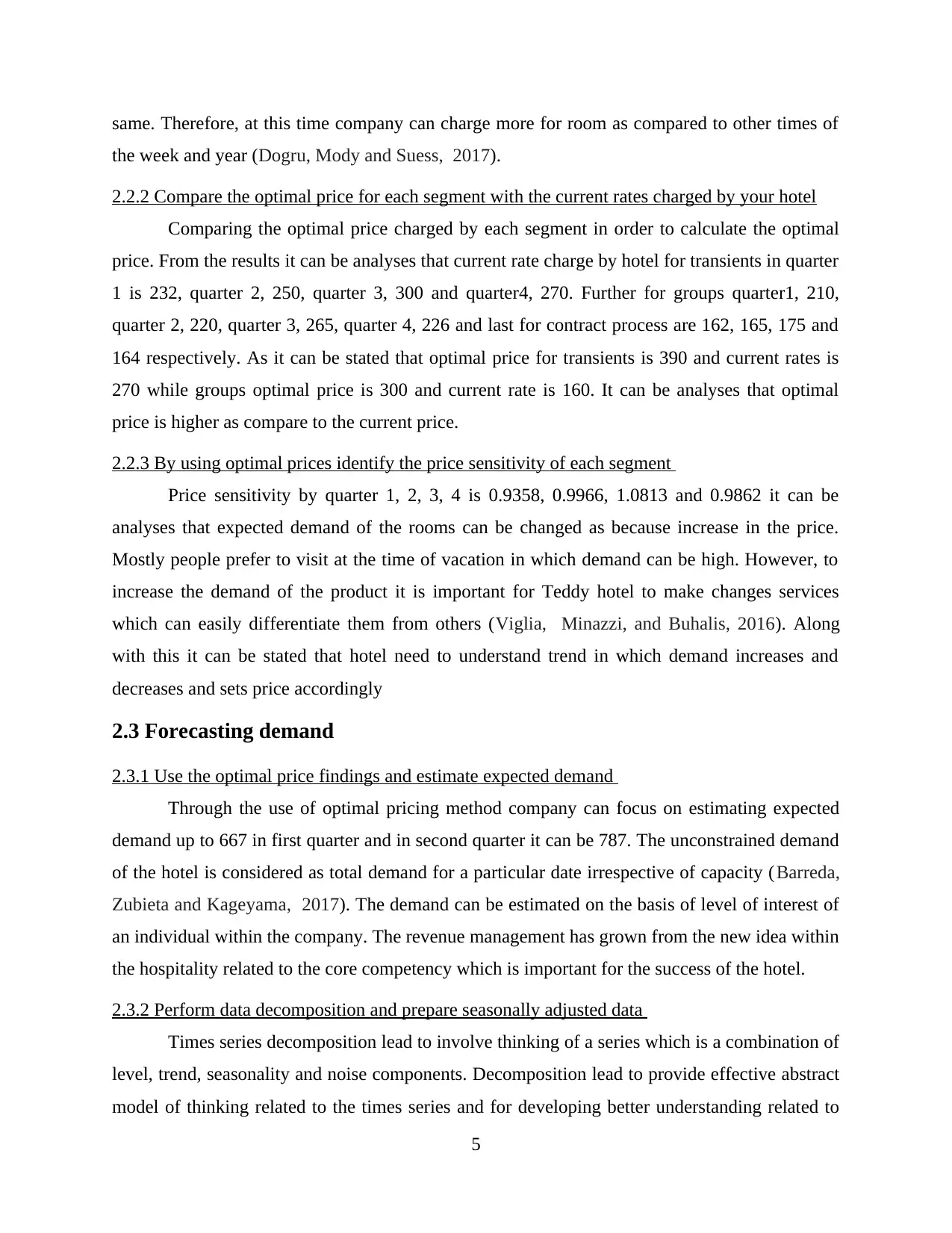
same. Therefore, at this time company can charge more for room as compared to other times of
the week and year (Dogru, Mody and Suess, 2017).
2.2.2 Compare the optimal price for each segment with the current rates charged by your hotel
Comparing the optimal price charged by each segment in order to calculate the optimal
price. From the results it can be analyses that current rate charge by hotel for transients in quarter
1 is 232, quarter 2, 250, quarter 3, 300 and quarter4, 270. Further for groups quarter1, 210,
quarter 2, 220, quarter 3, 265, quarter 4, 226 and last for contract process are 162, 165, 175 and
164 respectively. As it can be stated that optimal price for transients is 390 and current rates is
270 while groups optimal price is 300 and current rate is 160. It can be analyses that optimal
price is higher as compare to the current price.
2.2.3 By using optimal prices identify the price sensitivity of each segment
Price sensitivity by quarter 1, 2, 3, 4 is 0.9358, 0.9966, 1.0813 and 0.9862 it can be
analyses that expected demand of the rooms can be changed as because increase in the price.
Mostly people prefer to visit at the time of vacation in which demand can be high. However, to
increase the demand of the product it is important for Teddy hotel to make changes services
which can easily differentiate them from others (Viglia, Minazzi, and Buhalis, 2016). Along
with this it can be stated that hotel need to understand trend in which demand increases and
decreases and sets price accordingly
2.3 Forecasting demand
2.3.1 Use the optimal price findings and estimate expected demand
Through the use of optimal pricing method company can focus on estimating expected
demand up to 667 in first quarter and in second quarter it can be 787. The unconstrained demand
of the hotel is considered as total demand for a particular date irrespective of capacity (Barreda,
Zubieta and Kageyama, 2017). The demand can be estimated on the basis of level of interest of
an individual within the company. The revenue management has grown from the new idea within
the hospitality related to the core competency which is important for the success of the hotel.
2.3.2 Perform data decomposition and prepare seasonally adjusted data
Times series decomposition lead to involve thinking of a series which is a combination of
level, trend, seasonality and noise components. Decomposition lead to provide effective abstract
model of thinking related to the times series and for developing better understanding related to
5
the week and year (Dogru, Mody and Suess, 2017).
2.2.2 Compare the optimal price for each segment with the current rates charged by your hotel
Comparing the optimal price charged by each segment in order to calculate the optimal
price. From the results it can be analyses that current rate charge by hotel for transients in quarter
1 is 232, quarter 2, 250, quarter 3, 300 and quarter4, 270. Further for groups quarter1, 210,
quarter 2, 220, quarter 3, 265, quarter 4, 226 and last for contract process are 162, 165, 175 and
164 respectively. As it can be stated that optimal price for transients is 390 and current rates is
270 while groups optimal price is 300 and current rate is 160. It can be analyses that optimal
price is higher as compare to the current price.
2.2.3 By using optimal prices identify the price sensitivity of each segment
Price sensitivity by quarter 1, 2, 3, 4 is 0.9358, 0.9966, 1.0813 and 0.9862 it can be
analyses that expected demand of the rooms can be changed as because increase in the price.
Mostly people prefer to visit at the time of vacation in which demand can be high. However, to
increase the demand of the product it is important for Teddy hotel to make changes services
which can easily differentiate them from others (Viglia, Minazzi, and Buhalis, 2016). Along
with this it can be stated that hotel need to understand trend in which demand increases and
decreases and sets price accordingly
2.3 Forecasting demand
2.3.1 Use the optimal price findings and estimate expected demand
Through the use of optimal pricing method company can focus on estimating expected
demand up to 667 in first quarter and in second quarter it can be 787. The unconstrained demand
of the hotel is considered as total demand for a particular date irrespective of capacity (Barreda,
Zubieta and Kageyama, 2017). The demand can be estimated on the basis of level of interest of
an individual within the company. The revenue management has grown from the new idea within
the hospitality related to the core competency which is important for the success of the hotel.
2.3.2 Perform data decomposition and prepare seasonally adjusted data
Times series decomposition lead to involve thinking of a series which is a combination of
level, trend, seasonality and noise components. Decomposition lead to provide effective abstract
model of thinking related to the times series and for developing better understanding related to
5
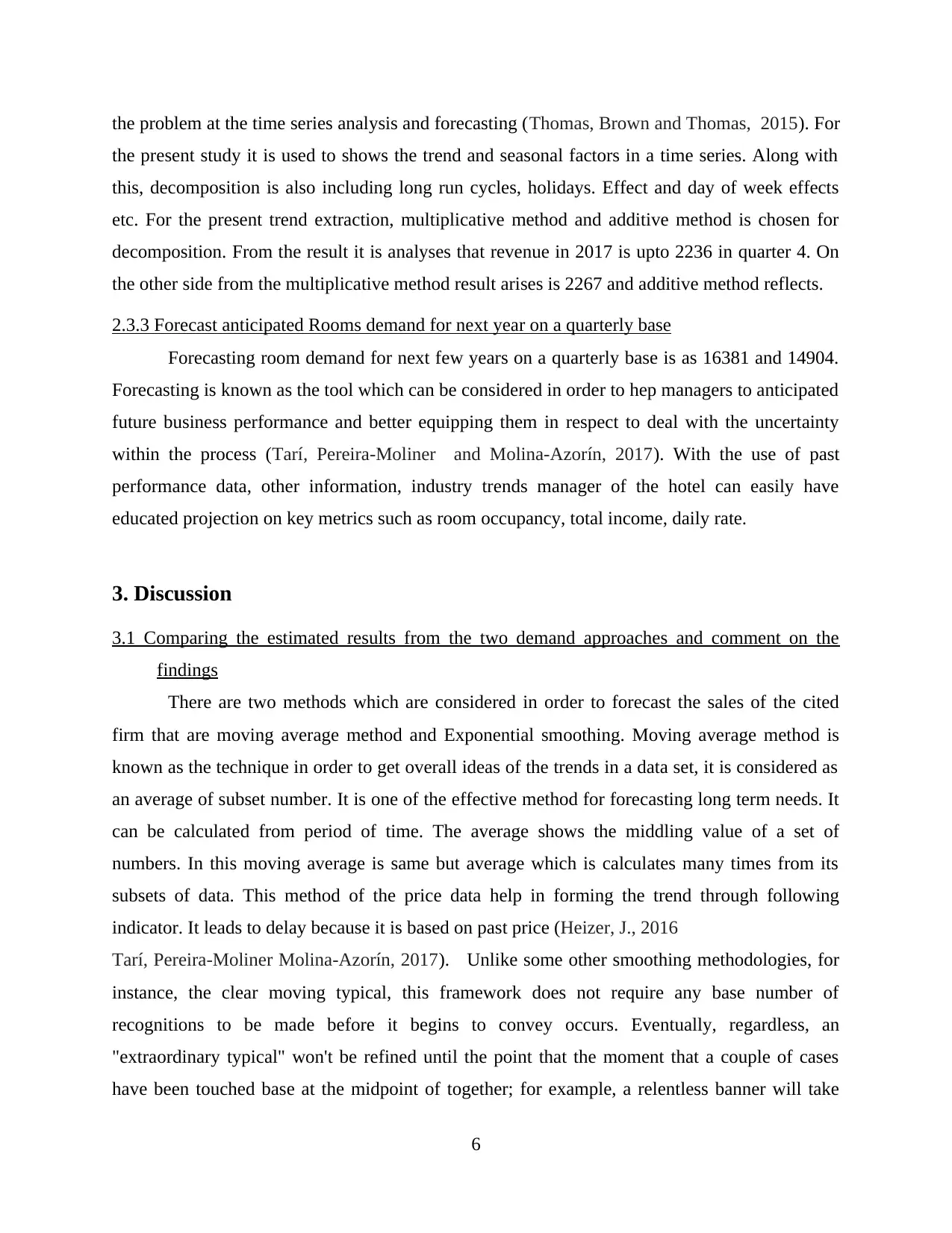
the problem at the time series analysis and forecasting (Thomas, Brown and Thomas, 2015). For
the present study it is used to shows the trend and seasonal factors in a time series. Along with
this, decomposition is also including long run cycles, holidays. Effect and day of week effects
etc. For the present trend extraction, multiplicative method and additive method is chosen for
decomposition. From the result it is analyses that revenue in 2017 is upto 2236 in quarter 4. On
the other side from the multiplicative method result arises is 2267 and additive method reflects.
2.3.3 Forecast anticipated Rooms demand for next year on a quarterly base
Forecasting room demand for next few years on a quarterly base is as 16381 and 14904.
Forecasting is known as the tool which can be considered in order to hep managers to anticipated
future business performance and better equipping them in respect to deal with the uncertainty
within the process (Tarí, Pereira-Moliner and Molina-Azorín, 2017). With the use of past
performance data, other information, industry trends manager of the hotel can easily have
educated projection on key metrics such as room occupancy, total income, daily rate.
3. Discussion
3.1 Comparing the estimated results from the two demand approaches and comment on the
findings
There are two methods which are considered in order to forecast the sales of the cited
firm that are moving average method and Exponential smoothing. Moving average method is
known as the technique in order to get overall ideas of the trends in a data set, it is considered as
an average of subset number. It is one of the effective method for forecasting long term needs. It
can be calculated from period of time. The average shows the middling value of a set of
numbers. In this moving average is same but average which is calculates many times from its
subsets of data. This method of the price data help in forming the trend through following
indicator. It leads to delay because it is based on past price (Heizer, J., 2016
Tarí, Pereira-Moliner Molina-Azorín, 2017). Unlike some other smoothing methodologies, for
instance, the clear moving typical, this framework does not require any base number of
recognitions to be made before it begins to convey occurs. Eventually, regardless, an
"extraordinary typical" won't be refined until the point that the moment that a couple of cases
have been touched base at the midpoint of together; for example, a relentless banner will take
6
the present study it is used to shows the trend and seasonal factors in a time series. Along with
this, decomposition is also including long run cycles, holidays. Effect and day of week effects
etc. For the present trend extraction, multiplicative method and additive method is chosen for
decomposition. From the result it is analyses that revenue in 2017 is upto 2236 in quarter 4. On
the other side from the multiplicative method result arises is 2267 and additive method reflects.
2.3.3 Forecast anticipated Rooms demand for next year on a quarterly base
Forecasting room demand for next few years on a quarterly base is as 16381 and 14904.
Forecasting is known as the tool which can be considered in order to hep managers to anticipated
future business performance and better equipping them in respect to deal with the uncertainty
within the process (Tarí, Pereira-Moliner and Molina-Azorín, 2017). With the use of past
performance data, other information, industry trends manager of the hotel can easily have
educated projection on key metrics such as room occupancy, total income, daily rate.
3. Discussion
3.1 Comparing the estimated results from the two demand approaches and comment on the
findings
There are two methods which are considered in order to forecast the sales of the cited
firm that are moving average method and Exponential smoothing. Moving average method is
known as the technique in order to get overall ideas of the trends in a data set, it is considered as
an average of subset number. It is one of the effective method for forecasting long term needs. It
can be calculated from period of time. The average shows the middling value of a set of
numbers. In this moving average is same but average which is calculates many times from its
subsets of data. This method of the price data help in forming the trend through following
indicator. It leads to delay because it is based on past price (Heizer, J., 2016
Tarí, Pereira-Moliner Molina-Azorín, 2017). Unlike some other smoothing methodologies, for
instance, the clear moving typical, this framework does not require any base number of
recognitions to be made before it begins to convey occurs. Eventually, regardless, an
"extraordinary typical" won't be refined until the point that the moment that a couple of cases
have been touched base at the midpoint of together; for example, a relentless banner will take
6
⊘ This is a preview!⊘
Do you want full access?
Subscribe today to unlock all pages.

Trusted by 1+ million students worldwide
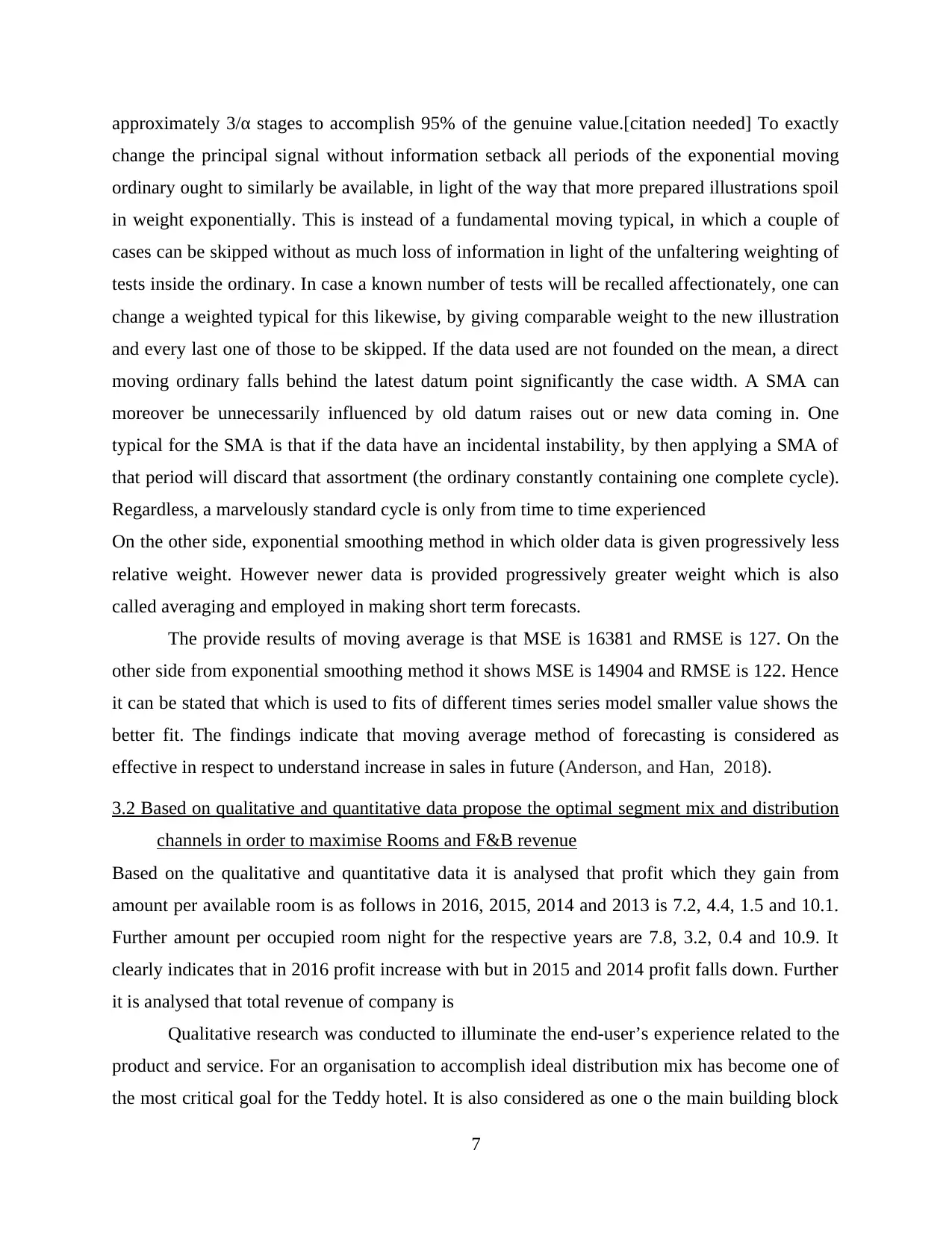
approximately 3/α stages to accomplish 95% of the genuine value.[citation needed] To exactly
change the principal signal without information setback all periods of the exponential moving
ordinary ought to similarly be available, in light of the way that more prepared illustrations spoil
in weight exponentially. This is instead of a fundamental moving typical, in which a couple of
cases can be skipped without as much loss of information in light of the unfaltering weighting of
tests inside the ordinary. In case a known number of tests will be recalled affectionately, one can
change a weighted typical for this likewise, by giving comparable weight to the new illustration
and every last one of those to be skipped. If the data used are not founded on the mean, a direct
moving ordinary falls behind the latest datum point significantly the case width. A SMA can
moreover be unnecessarily influenced by old datum raises out or new data coming in. One
typical for the SMA is that if the data have an incidental instability, by then applying a SMA of
that period will discard that assortment (the ordinary constantly containing one complete cycle).
Regardless, a marvelously standard cycle is only from time to time experienced
On the other side, exponential smoothing method in which older data is given progressively less
relative weight. However newer data is provided progressively greater weight which is also
called averaging and employed in making short term forecasts.
The provide results of moving average is that MSE is 16381 and RMSE is 127. On the
other side from exponential smoothing method it shows MSE is 14904 and RMSE is 122. Hence
it can be stated that which is used to fits of different times series model smaller value shows the
better fit. The findings indicate that moving average method of forecasting is considered as
effective in respect to understand increase in sales in future (Anderson, and Han, 2018).
3.2 Based on qualitative and quantitative data propose the optimal segment mix and distribution
channels in order to maximise Rooms and F&B revenue
Based on the qualitative and quantitative data it is analysed that profit which they gain from
amount per available room is as follows in 2016, 2015, 2014 and 2013 is 7.2, 4.4, 1.5 and 10.1.
Further amount per occupied room night for the respective years are 7.8, 3.2, 0.4 and 10.9. It
clearly indicates that in 2016 profit increase with but in 2015 and 2014 profit falls down. Further
it is analysed that total revenue of company is
Qualitative research was conducted to illuminate the end-user’s experience related to the
product and service. For an organisation to accomplish ideal distribution mix has become one of
the most critical goal for the Teddy hotel. It is also considered as one o the main building block
7
change the principal signal without information setback all periods of the exponential moving
ordinary ought to similarly be available, in light of the way that more prepared illustrations spoil
in weight exponentially. This is instead of a fundamental moving typical, in which a couple of
cases can be skipped without as much loss of information in light of the unfaltering weighting of
tests inside the ordinary. In case a known number of tests will be recalled affectionately, one can
change a weighted typical for this likewise, by giving comparable weight to the new illustration
and every last one of those to be skipped. If the data used are not founded on the mean, a direct
moving ordinary falls behind the latest datum point significantly the case width. A SMA can
moreover be unnecessarily influenced by old datum raises out or new data coming in. One
typical for the SMA is that if the data have an incidental instability, by then applying a SMA of
that period will discard that assortment (the ordinary constantly containing one complete cycle).
Regardless, a marvelously standard cycle is only from time to time experienced
On the other side, exponential smoothing method in which older data is given progressively less
relative weight. However newer data is provided progressively greater weight which is also
called averaging and employed in making short term forecasts.
The provide results of moving average is that MSE is 16381 and RMSE is 127. On the
other side from exponential smoothing method it shows MSE is 14904 and RMSE is 122. Hence
it can be stated that which is used to fits of different times series model smaller value shows the
better fit. The findings indicate that moving average method of forecasting is considered as
effective in respect to understand increase in sales in future (Anderson, and Han, 2018).
3.2 Based on qualitative and quantitative data propose the optimal segment mix and distribution
channels in order to maximise Rooms and F&B revenue
Based on the qualitative and quantitative data it is analysed that profit which they gain from
amount per available room is as follows in 2016, 2015, 2014 and 2013 is 7.2, 4.4, 1.5 and 10.1.
Further amount per occupied room night for the respective years are 7.8, 3.2, 0.4 and 10.9. It
clearly indicates that in 2016 profit increase with but in 2015 and 2014 profit falls down. Further
it is analysed that total revenue of company is
Qualitative research was conducted to illuminate the end-user’s experience related to the
product and service. For an organisation to accomplish ideal distribution mix has become one of
the most critical goal for the Teddy hotel. It is also considered as one o the main building block
7
Paraphrase This Document
Need a fresh take? Get an instant paraphrase of this document with our AI Paraphraser
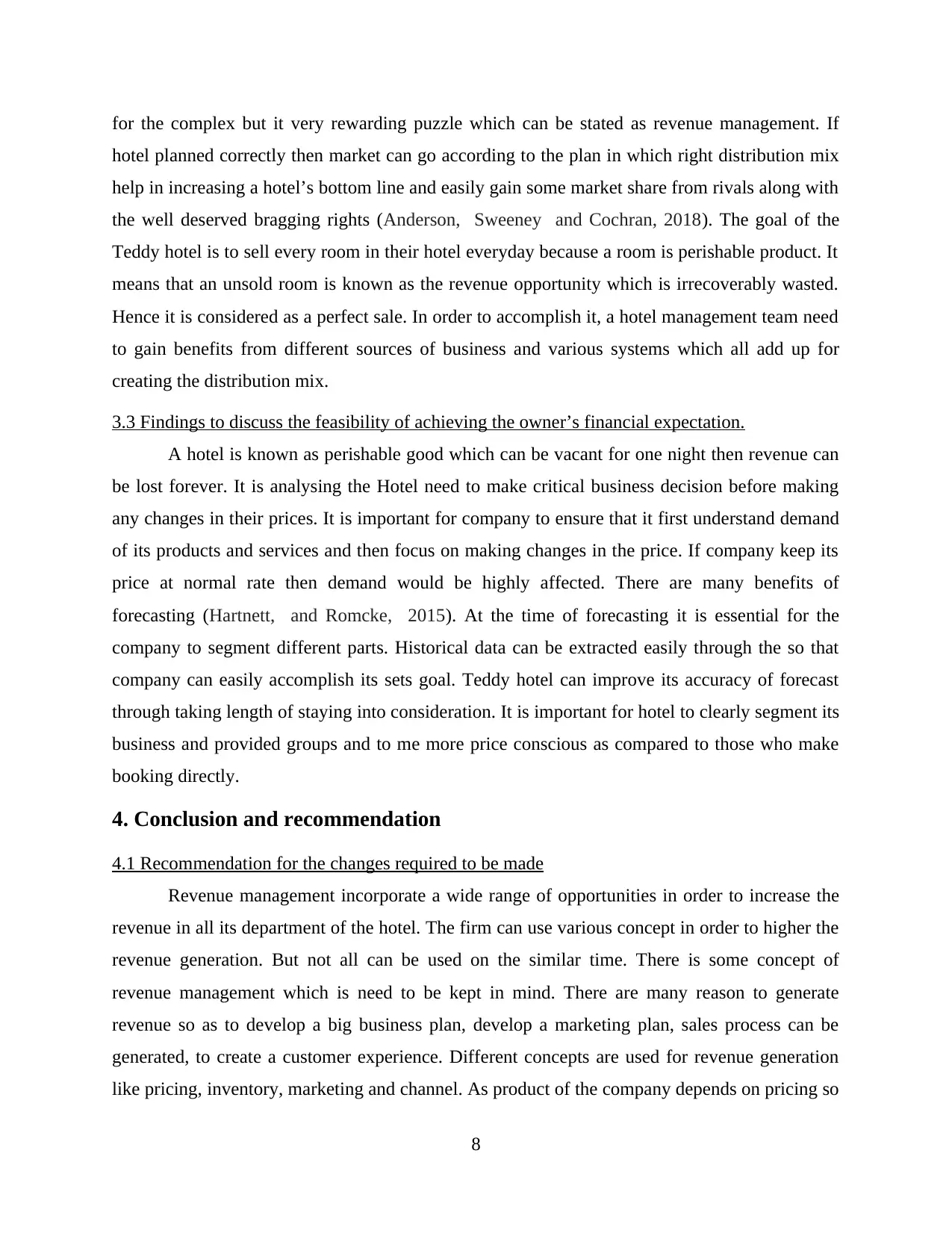
for the complex but it very rewarding puzzle which can be stated as revenue management. If
hotel planned correctly then market can go according to the plan in which right distribution mix
help in increasing a hotel’s bottom line and easily gain some market share from rivals along with
the well deserved bragging rights (Anderson, Sweeney and Cochran, 2018). The goal of the
Teddy hotel is to sell every room in their hotel everyday because a room is perishable product. It
means that an unsold room is known as the revenue opportunity which is irrecoverably wasted.
Hence it is considered as a perfect sale. In order to accomplish it, a hotel management team need
to gain benefits from different sources of business and various systems which all add up for
creating the distribution mix.
3.3 Findings to discuss the feasibility of achieving the owner’s financial expectation.
A hotel is known as perishable good which can be vacant for one night then revenue can
be lost forever. It is analysing the Hotel need to make critical business decision before making
any changes in their prices. It is important for company to ensure that it first understand demand
of its products and services and then focus on making changes in the price. If company keep its
price at normal rate then demand would be highly affected. There are many benefits of
forecasting (Hartnett, and Romcke, 2015). At the time of forecasting it is essential for the
company to segment different parts. Historical data can be extracted easily through the so that
company can easily accomplish its sets goal. Teddy hotel can improve its accuracy of forecast
through taking length of staying into consideration. It is important for hotel to clearly segment its
business and provided groups and to me more price conscious as compared to those who make
booking directly.
4. Conclusion and recommendation
4.1 Recommendation for the changes required to be made
Revenue management incorporate a wide range of opportunities in order to increase the
revenue in all its department of the hotel. The firm can use various concept in order to higher the
revenue generation. But not all can be used on the similar time. There is some concept of
revenue management which is need to be kept in mind. There are many reason to generate
revenue so as to develop a big business plan, develop a marketing plan, sales process can be
generated, to create a customer experience. Different concepts are used for revenue generation
like pricing, inventory, marketing and channel. As product of the company depends on pricing so
8
hotel planned correctly then market can go according to the plan in which right distribution mix
help in increasing a hotel’s bottom line and easily gain some market share from rivals along with
the well deserved bragging rights (Anderson, Sweeney and Cochran, 2018). The goal of the
Teddy hotel is to sell every room in their hotel everyday because a room is perishable product. It
means that an unsold room is known as the revenue opportunity which is irrecoverably wasted.
Hence it is considered as a perfect sale. In order to accomplish it, a hotel management team need
to gain benefits from different sources of business and various systems which all add up for
creating the distribution mix.
3.3 Findings to discuss the feasibility of achieving the owner’s financial expectation.
A hotel is known as perishable good which can be vacant for one night then revenue can
be lost forever. It is analysing the Hotel need to make critical business decision before making
any changes in their prices. It is important for company to ensure that it first understand demand
of its products and services and then focus on making changes in the price. If company keep its
price at normal rate then demand would be highly affected. There are many benefits of
forecasting (Hartnett, and Romcke, 2015). At the time of forecasting it is essential for the
company to segment different parts. Historical data can be extracted easily through the so that
company can easily accomplish its sets goal. Teddy hotel can improve its accuracy of forecast
through taking length of staying into consideration. It is important for hotel to clearly segment its
business and provided groups and to me more price conscious as compared to those who make
booking directly.
4. Conclusion and recommendation
4.1 Recommendation for the changes required to be made
Revenue management incorporate a wide range of opportunities in order to increase the
revenue in all its department of the hotel. The firm can use various concept in order to higher the
revenue generation. But not all can be used on the similar time. There is some concept of
revenue management which is need to be kept in mind. There are many reason to generate
revenue so as to develop a big business plan, develop a marketing plan, sales process can be
generated, to create a customer experience. Different concepts are used for revenue generation
like pricing, inventory, marketing and channel. As product of the company depends on pricing so
8
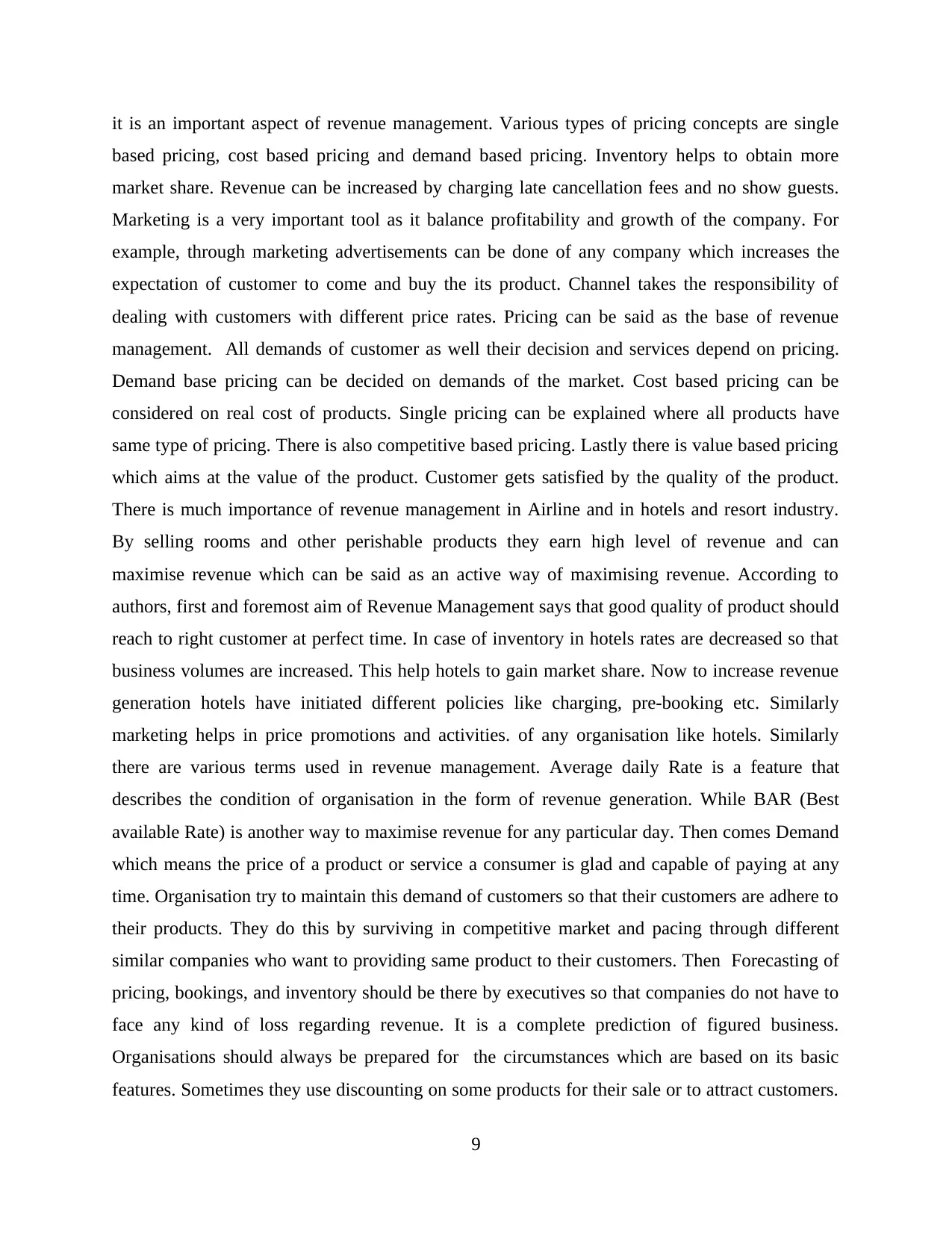
it is an important aspect of revenue management. Various types of pricing concepts are single
based pricing, cost based pricing and demand based pricing. Inventory helps to obtain more
market share. Revenue can be increased by charging late cancellation fees and no show guests.
Marketing is a very important tool as it balance profitability and growth of the company. For
example, through marketing advertisements can be done of any company which increases the
expectation of customer to come and buy the its product. Channel takes the responsibility of
dealing with customers with different price rates. Pricing can be said as the base of revenue
management. All demands of customer as well their decision and services depend on pricing.
Demand base pricing can be decided on demands of the market. Cost based pricing can be
considered on real cost of products. Single pricing can be explained where all products have
same type of pricing. There is also competitive based pricing. Lastly there is value based pricing
which aims at the value of the product. Customer gets satisfied by the quality of the product.
There is much importance of revenue management in Airline and in hotels and resort industry.
By selling rooms and other perishable products they earn high level of revenue and can
maximise revenue which can be said as an active way of maximising revenue. According to
authors, first and foremost aim of Revenue Management says that good quality of product should
reach to right customer at perfect time. In case of inventory in hotels rates are decreased so that
business volumes are increased. This help hotels to gain market share. Now to increase revenue
generation hotels have initiated different policies like charging, pre-booking etc. Similarly
marketing helps in price promotions and activities. of any organisation like hotels. Similarly
there are various terms used in revenue management. Average daily Rate is a feature that
describes the condition of organisation in the form of revenue generation. While BAR (Best
available Rate) is another way to maximise revenue for any particular day. Then comes Demand
which means the price of a product or service a consumer is glad and capable of paying at any
time. Organisation try to maintain this demand of customers so that their customers are adhere to
their products. They do this by surviving in competitive market and pacing through different
similar companies who want to providing same product to their customers. Then Forecasting of
pricing, bookings, and inventory should be there by executives so that companies do not have to
face any kind of loss regarding revenue. It is a complete prediction of figured business.
Organisations should always be prepared for the circumstances which are based on its basic
features. Sometimes they use discounting on some products for their sale or to attract customers.
9
based pricing, cost based pricing and demand based pricing. Inventory helps to obtain more
market share. Revenue can be increased by charging late cancellation fees and no show guests.
Marketing is a very important tool as it balance profitability and growth of the company. For
example, through marketing advertisements can be done of any company which increases the
expectation of customer to come and buy the its product. Channel takes the responsibility of
dealing with customers with different price rates. Pricing can be said as the base of revenue
management. All demands of customer as well their decision and services depend on pricing.
Demand base pricing can be decided on demands of the market. Cost based pricing can be
considered on real cost of products. Single pricing can be explained where all products have
same type of pricing. There is also competitive based pricing. Lastly there is value based pricing
which aims at the value of the product. Customer gets satisfied by the quality of the product.
There is much importance of revenue management in Airline and in hotels and resort industry.
By selling rooms and other perishable products they earn high level of revenue and can
maximise revenue which can be said as an active way of maximising revenue. According to
authors, first and foremost aim of Revenue Management says that good quality of product should
reach to right customer at perfect time. In case of inventory in hotels rates are decreased so that
business volumes are increased. This help hotels to gain market share. Now to increase revenue
generation hotels have initiated different policies like charging, pre-booking etc. Similarly
marketing helps in price promotions and activities. of any organisation like hotels. Similarly
there are various terms used in revenue management. Average daily Rate is a feature that
describes the condition of organisation in the form of revenue generation. While BAR (Best
available Rate) is another way to maximise revenue for any particular day. Then comes Demand
which means the price of a product or service a consumer is glad and capable of paying at any
time. Organisation try to maintain this demand of customers so that their customers are adhere to
their products. They do this by surviving in competitive market and pacing through different
similar companies who want to providing same product to their customers. Then Forecasting of
pricing, bookings, and inventory should be there by executives so that companies do not have to
face any kind of loss regarding revenue. It is a complete prediction of figured business.
Organisations should always be prepared for the circumstances which are based on its basic
features. Sometimes they use discounting on some products for their sale or to attract customers.
9
⊘ This is a preview!⊘
Do you want full access?
Subscribe today to unlock all pages.

Trusted by 1+ million students worldwide
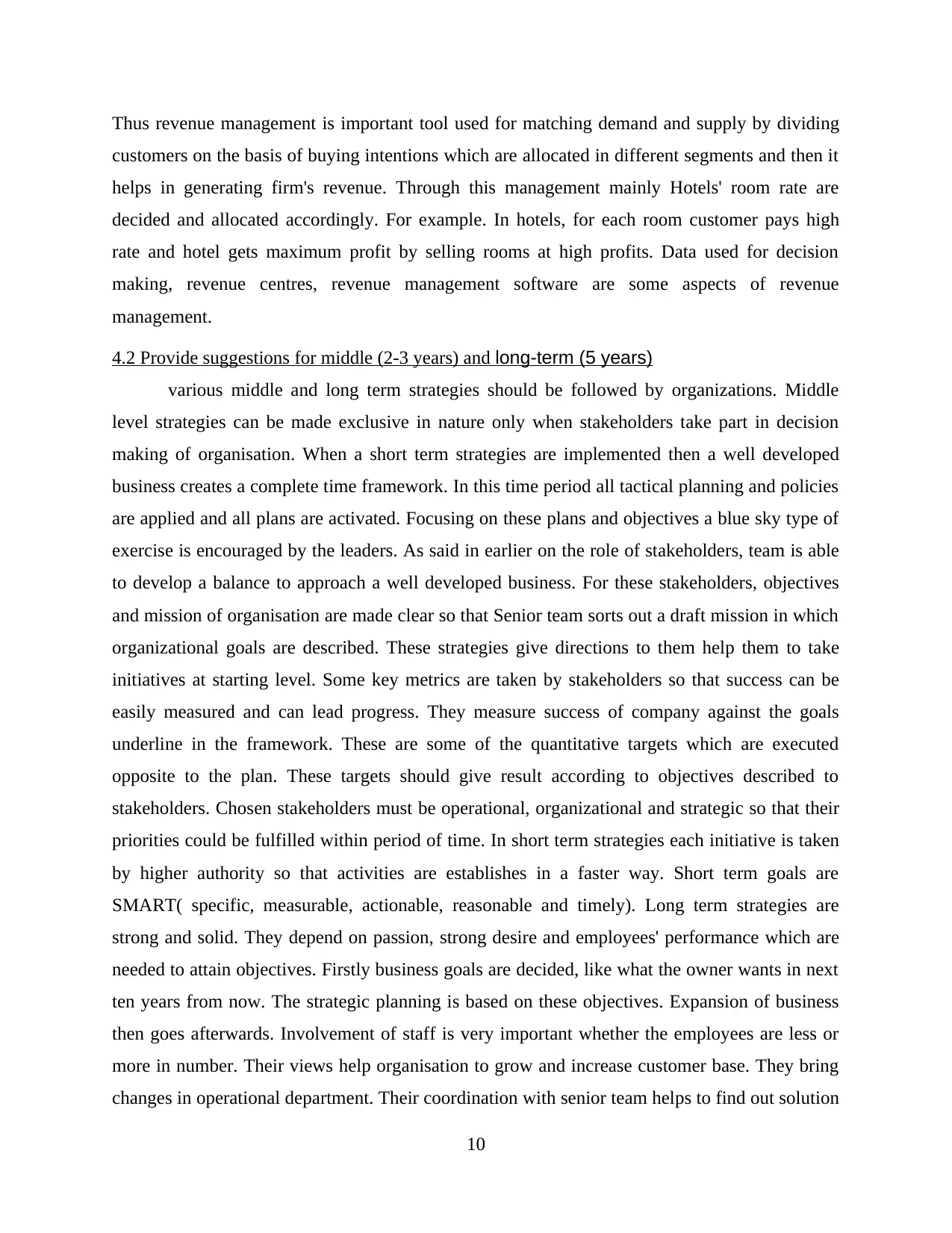
Thus revenue management is important tool used for matching demand and supply by dividing
customers on the basis of buying intentions which are allocated in different segments and then it
helps in generating firm's revenue. Through this management mainly Hotels' room rate are
decided and allocated accordingly. For example. In hotels, for each room customer pays high
rate and hotel gets maximum profit by selling rooms at high profits. Data used for decision
making, revenue centres, revenue management software are some aspects of revenue
management.
4.2 Provide suggestions for middle (2-3 years) and long-term (5 years)
various middle and long term strategies should be followed by organizations. Middle
level strategies can be made exclusive in nature only when stakeholders take part in decision
making of organisation. When a short term strategies are implemented then a well developed
business creates a complete time framework. In this time period all tactical planning and policies
are applied and all plans are activated. Focusing on these plans and objectives a blue sky type of
exercise is encouraged by the leaders. As said in earlier on the role of stakeholders, team is able
to develop a balance to approach a well developed business. For these stakeholders, objectives
and mission of organisation are made clear so that Senior team sorts out a draft mission in which
organizational goals are described. These strategies give directions to them help them to take
initiatives at starting level. Some key metrics are taken by stakeholders so that success can be
easily measured and can lead progress. They measure success of company against the goals
underline in the framework. These are some of the quantitative targets which are executed
opposite to the plan. These targets should give result according to objectives described to
stakeholders. Chosen stakeholders must be operational, organizational and strategic so that their
priorities could be fulfilled within period of time. In short term strategies each initiative is taken
by higher authority so that activities are establishes in a faster way. Short term goals are
SMART( specific, measurable, actionable, reasonable and timely). Long term strategies are
strong and solid. They depend on passion, strong desire and employees' performance which are
needed to attain objectives. Firstly business goals are decided, like what the owner wants in next
ten years from now. The strategic planning is based on these objectives. Expansion of business
then goes afterwards. Involvement of staff is very important whether the employees are less or
more in number. Their views help organisation to grow and increase customer base. They bring
changes in operational department. Their coordination with senior team helps to find out solution
10
customers on the basis of buying intentions which are allocated in different segments and then it
helps in generating firm's revenue. Through this management mainly Hotels' room rate are
decided and allocated accordingly. For example. In hotels, for each room customer pays high
rate and hotel gets maximum profit by selling rooms at high profits. Data used for decision
making, revenue centres, revenue management software are some aspects of revenue
management.
4.2 Provide suggestions for middle (2-3 years) and long-term (5 years)
various middle and long term strategies should be followed by organizations. Middle
level strategies can be made exclusive in nature only when stakeholders take part in decision
making of organisation. When a short term strategies are implemented then a well developed
business creates a complete time framework. In this time period all tactical planning and policies
are applied and all plans are activated. Focusing on these plans and objectives a blue sky type of
exercise is encouraged by the leaders. As said in earlier on the role of stakeholders, team is able
to develop a balance to approach a well developed business. For these stakeholders, objectives
and mission of organisation are made clear so that Senior team sorts out a draft mission in which
organizational goals are described. These strategies give directions to them help them to take
initiatives at starting level. Some key metrics are taken by stakeholders so that success can be
easily measured and can lead progress. They measure success of company against the goals
underline in the framework. These are some of the quantitative targets which are executed
opposite to the plan. These targets should give result according to objectives described to
stakeholders. Chosen stakeholders must be operational, organizational and strategic so that their
priorities could be fulfilled within period of time. In short term strategies each initiative is taken
by higher authority so that activities are establishes in a faster way. Short term goals are
SMART( specific, measurable, actionable, reasonable and timely). Long term strategies are
strong and solid. They depend on passion, strong desire and employees' performance which are
needed to attain objectives. Firstly business goals are decided, like what the owner wants in next
ten years from now. The strategic planning is based on these objectives. Expansion of business
then goes afterwards. Involvement of staff is very important whether the employees are less or
more in number. Their views help organisation to grow and increase customer base. They bring
changes in operational department. Their coordination with senior team helps to find out solution
10
Paraphrase This Document
Need a fresh take? Get an instant paraphrase of this document with our AI Paraphraser
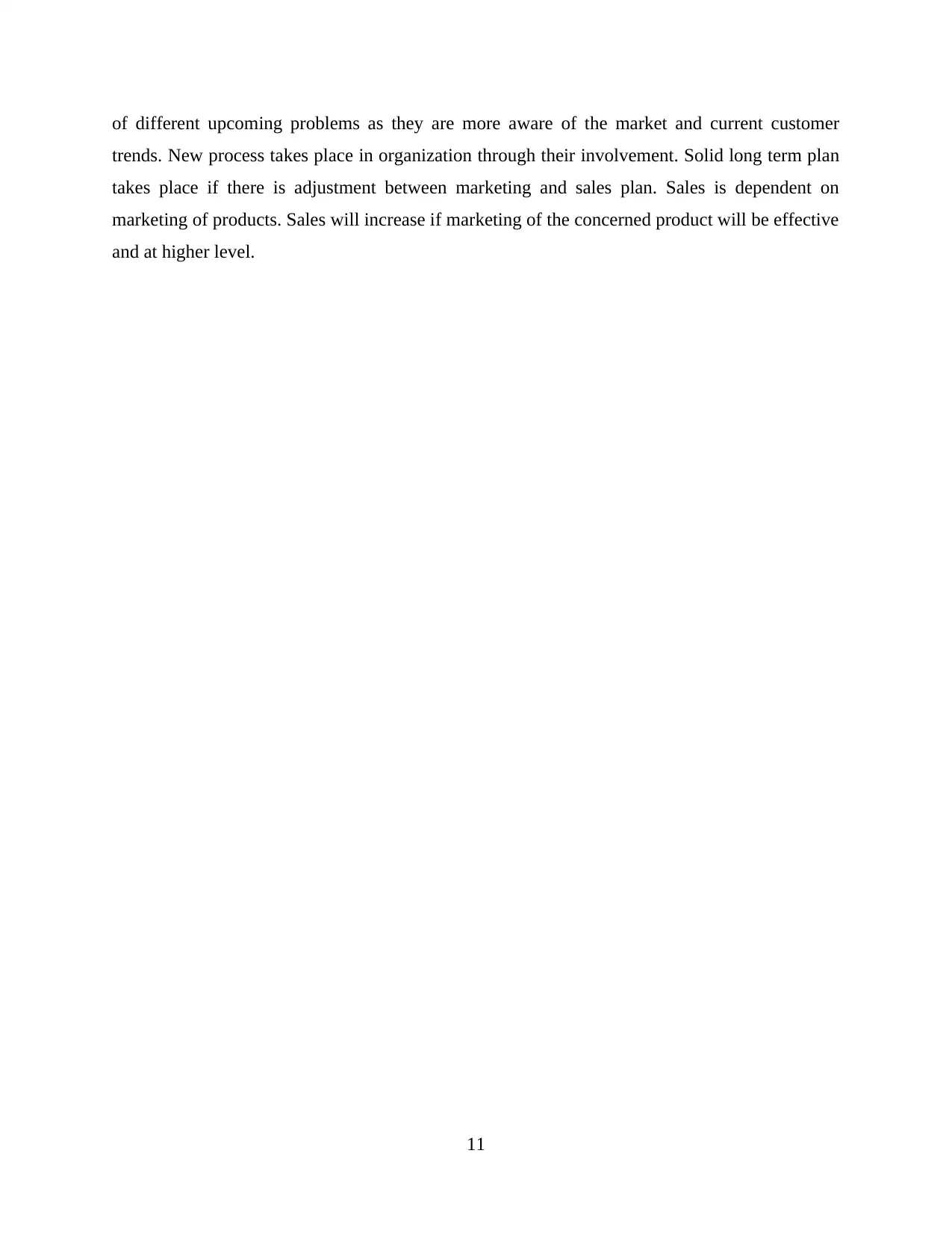
of different upcoming problems as they are more aware of the market and current customer
trends. New process takes place in organization through their involvement. Solid long term plan
takes place if there is adjustment between marketing and sales plan. Sales is dependent on
marketing of products. Sales will increase if marketing of the concerned product will be effective
and at higher level.
11
trends. New process takes place in organization through their involvement. Solid long term plan
takes place if there is adjustment between marketing and sales plan. Sales is dependent on
marketing of products. Sales will increase if marketing of the concerned product will be effective
and at higher level.
11
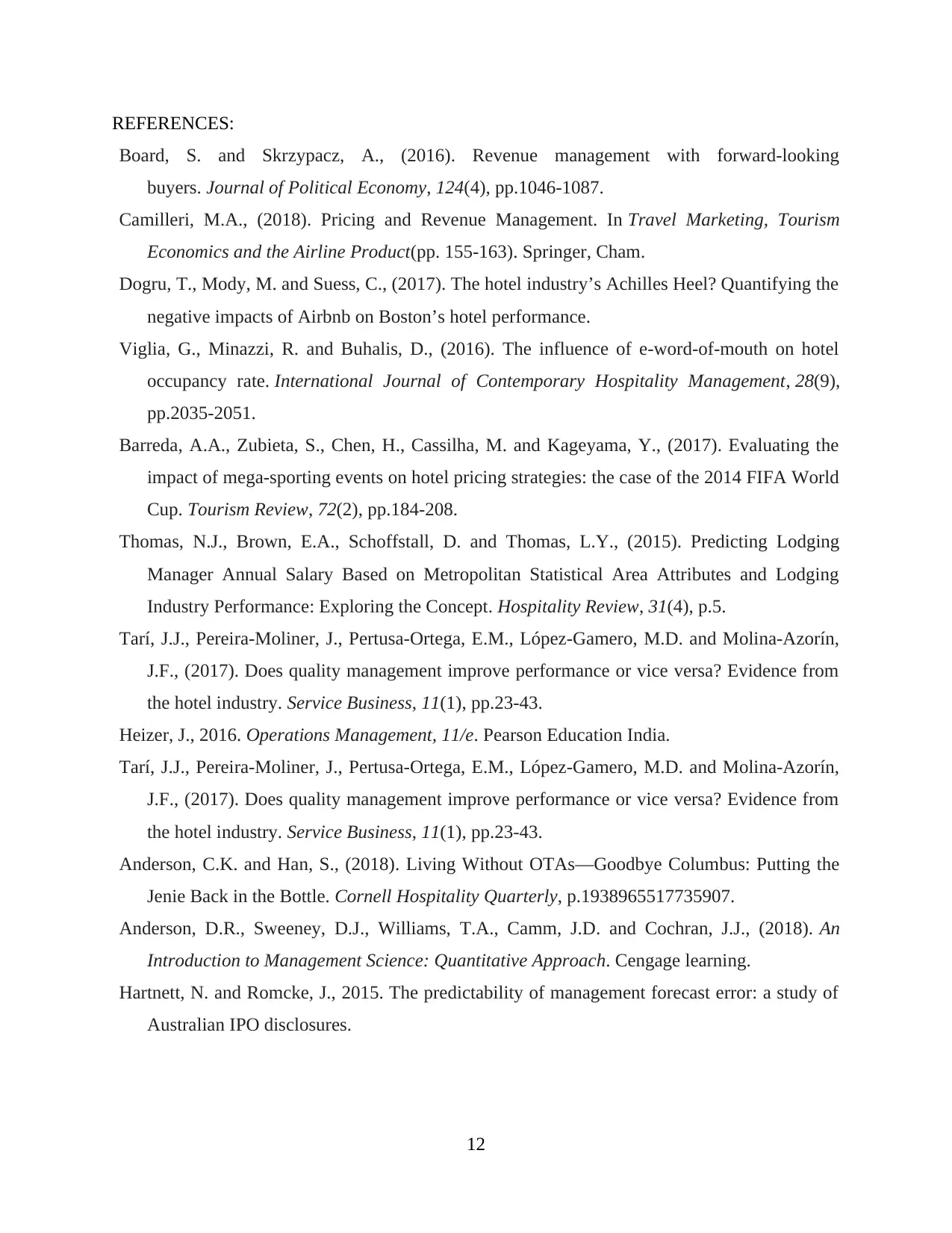
REFERENCES:
Board, S. and Skrzypacz, A., (2016). Revenue management with forward-looking
buyers. Journal of Political Economy, 124(4), pp.1046-1087.
Camilleri, M.A., (2018). Pricing and Revenue Management. In Travel Marketing, Tourism
Economics and the Airline Product(pp. 155-163). Springer, Cham.
Dogru, T., Mody, M. and Suess, C., (2017). The hotel industry’s Achilles Heel? Quantifying the
negative impacts of Airbnb on Boston’s hotel performance.
Viglia, G., Minazzi, R. and Buhalis, D., (2016). The influence of e-word-of-mouth on hotel
occupancy rate. International Journal of Contemporary Hospitality Management, 28(9),
pp.2035-2051.
Barreda, A.A., Zubieta, S., Chen, H., Cassilha, M. and Kageyama, Y., (2017). Evaluating the
impact of mega-sporting events on hotel pricing strategies: the case of the 2014 FIFA World
Cup. Tourism Review, 72(2), pp.184-208.
Thomas, N.J., Brown, E.A., Schoffstall, D. and Thomas, L.Y., (2015). Predicting Lodging
Manager Annual Salary Based on Metropolitan Statistical Area Attributes and Lodging
Industry Performance: Exploring the Concept. Hospitality Review, 31(4), p.5.
Tarí, J.J., Pereira-Moliner, J., Pertusa-Ortega, E.M., López-Gamero, M.D. and Molina-Azorín,
J.F., (2017). Does quality management improve performance or vice versa? Evidence from
the hotel industry. Service Business, 11(1), pp.23-43.
Heizer, J., 2016. Operations Management, 11/e. Pearson Education India.
Tarí, J.J., Pereira-Moliner, J., Pertusa-Ortega, E.M., López-Gamero, M.D. and Molina-Azorín,
J.F., (2017). Does quality management improve performance or vice versa? Evidence from
the hotel industry. Service Business, 11(1), pp.23-43.
Anderson, C.K. and Han, S., (2018). Living Without OTAs—Goodbye Columbus: Putting the
Jenie Back in the Bottle. Cornell Hospitality Quarterly, p.1938965517735907.
Anderson, D.R., Sweeney, D.J., Williams, T.A., Camm, J.D. and Cochran, J.J., (2018). An
Introduction to Management Science: Quantitative Approach. Cengage learning.
Hartnett, N. and Romcke, J., 2015. The predictability of management forecast error: a study of
Australian IPO disclosures.
12
Board, S. and Skrzypacz, A., (2016). Revenue management with forward-looking
buyers. Journal of Political Economy, 124(4), pp.1046-1087.
Camilleri, M.A., (2018). Pricing and Revenue Management. In Travel Marketing, Tourism
Economics and the Airline Product(pp. 155-163). Springer, Cham.
Dogru, T., Mody, M. and Suess, C., (2017). The hotel industry’s Achilles Heel? Quantifying the
negative impacts of Airbnb on Boston’s hotel performance.
Viglia, G., Minazzi, R. and Buhalis, D., (2016). The influence of e-word-of-mouth on hotel
occupancy rate. International Journal of Contemporary Hospitality Management, 28(9),
pp.2035-2051.
Barreda, A.A., Zubieta, S., Chen, H., Cassilha, M. and Kageyama, Y., (2017). Evaluating the
impact of mega-sporting events on hotel pricing strategies: the case of the 2014 FIFA World
Cup. Tourism Review, 72(2), pp.184-208.
Thomas, N.J., Brown, E.A., Schoffstall, D. and Thomas, L.Y., (2015). Predicting Lodging
Manager Annual Salary Based on Metropolitan Statistical Area Attributes and Lodging
Industry Performance: Exploring the Concept. Hospitality Review, 31(4), p.5.
Tarí, J.J., Pereira-Moliner, J., Pertusa-Ortega, E.M., López-Gamero, M.D. and Molina-Azorín,
J.F., (2017). Does quality management improve performance or vice versa? Evidence from
the hotel industry. Service Business, 11(1), pp.23-43.
Heizer, J., 2016. Operations Management, 11/e. Pearson Education India.
Tarí, J.J., Pereira-Moliner, J., Pertusa-Ortega, E.M., López-Gamero, M.D. and Molina-Azorín,
J.F., (2017). Does quality management improve performance or vice versa? Evidence from
the hotel industry. Service Business, 11(1), pp.23-43.
Anderson, C.K. and Han, S., (2018). Living Without OTAs—Goodbye Columbus: Putting the
Jenie Back in the Bottle. Cornell Hospitality Quarterly, p.1938965517735907.
Anderson, D.R., Sweeney, D.J., Williams, T.A., Camm, J.D. and Cochran, J.J., (2018). An
Introduction to Management Science: Quantitative Approach. Cengage learning.
Hartnett, N. and Romcke, J., 2015. The predictability of management forecast error: a study of
Australian IPO disclosures.
12
⊘ This is a preview!⊘
Do you want full access?
Subscribe today to unlock all pages.

Trusted by 1+ million students worldwide
1 out of 13
Related Documents
Your All-in-One AI-Powered Toolkit for Academic Success.
+13062052269
info@desklib.com
Available 24*7 on WhatsApp / Email
![[object Object]](/_next/static/media/star-bottom.7253800d.svg)
Unlock your academic potential
Copyright © 2020–2025 A2Z Services. All Rights Reserved. Developed and managed by ZUCOL.





